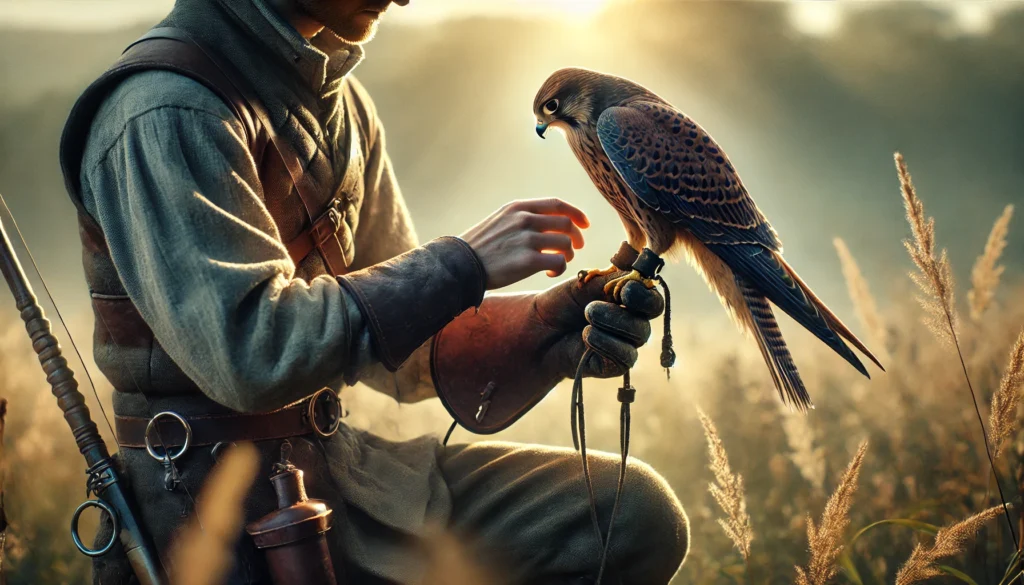Key Facts About Harris’s Hawks
- Harris’s hawks are known for their unique social behavior, often hunting in groups.
- These hawks have a stunning appearance with dark brown feathers, chestnut shoulders, and white markings on the tail.
- Their social nature makes them one of the easier raptors to train for falconry.
- They are native to the southwestern United States, ranging into Central and South America.
- Harris’s hawks have a varied diet including small mammals, birds, and lizards.
- Their ability to cooperate during hunts is compared to the hunting techniques of wolves.
- These hawks are known for their intelligence and problem-solving skills.
- They often nest in tall trees or cliffs, protecting their young from predators.
- Harris’s hawks are adaptable and can be seen in both desert areas and urban environments.
- Falconers highly regard them for their ease of training and strong bond with their human partners.
Discovering the Majestic Harris Hawks: A Falconry Treasure
Have you ever stumbled upon something so fascinating that it felt like finding a four-leaf clover in an Irish meadow? That’s exactly how you’ll feel when you learn about Harris Hawks in this article! At Learn Falconry, we’re all about sharing the joy and excitement of falconry, whether you’re a seasoned bird whisperer or just someone who’s passionately curious about these majestic creatures.
So, what’s so special about Harris Hawks, you ask? Imagine you’re on a grand adventure through the lush green hills of Ireland with your loyal and skillful hawk by your side, guiding your every step. These remarkable birds are not only stunning creatures of the sky, but they also have unique qualities that make them perfect companions for falconry enthusiasts.
We’ll delve into the intriguing world of Harris Hawks, uncovering their behaviors, hunting techniques, and why they are considered a treasure among falconers worldwide. Think of it like discovering the secret to the perfect Irish stew ‘ once you get a taste, you’ll want to know everything about how it’s made!
Stick around as we unravel the reasons why Harris Hawks are so special and why you’ll want to get to know them better. Trust us; this journey will be as delightful and enriching as a stroll through an enchanted emerald landscape with the friendliest of guides. Ready to be captivated? Let’s soar into the world of Harris Hawks together!
Discovering the Majestic Harris Hawk
If you’re passionate about falconry, then you’re probably familiar with the incredible Harris Hawk. Known for its unique hunting techniques and social behavior, the Harris species stands out among birds of prey. Dive in as we explore the fascinating aspects of the Harris Hawk and its significant role in Harris Hawk falconry.
The Charisma of the Harris Hawk
The Harris Hawk, originally from the southwestern United States, Central, and South America, is a popular choice among falconers. Its exceptional intelligence, gentle nature, and social hunting skills make it a favorite. These raptors can be identified by their dark brown plumage, chestnut-red shoulders, and white-tipped tails.
The Harris Species in Falconry
Falconers love the Harris species for many reasons. Harris Hawks are known for their cooperative hunting behavior, which is rare among raptors. This trait allows falconers to train multiple Harris Hawks to work together, simulating a natural pack hunt. Their trainability and adaptability also make them suitable for beginners Learn more about getting started in falconry.
Harris Hawk Falconry: Techniques and Training
When it comes to Harris Hawk falconry, training these birds involves an array of techniques. Basic training techniques include manning, lure training, and hood training. These methods help in building trust and communication between the falconer and the hawk. Harris Hawks are particularly responsive to positive reinforcement, making them easier to train compared to other raptor species.
Essential Falconry Equipment
Using the right falconry equipment is crucial when working with Harris Hawks. Essential items include gloves, jesses, and telemetry devices. Falconers also use specialized perches and stands to ensure the birds are comfortable and safe. You can explore more about the types of hoods and other equipment needed for successful falconry.
Health and Nutrition for Harris Hawks
Maintaining the health and nutrition of Harris Hawks is vital for their performance and well-being. Proper falcon health and nutrition practices include a balanced diet, regular health check-ups, and parasite control. A well-fed and healthy Harris Hawk is more energetic and responsive during training and hunting sessions.
Historical and Cultural Importance
Falconry has a rich history, and the Harris Hawk holds a special place in this ancient art. You can read more about the history of falconry and how Harris Hawks have been revered for their hunting prowess and social nature. The evolution of falconry techniques has also been significantly influenced by the contributions of the Harris species.
Harris Hawks in Modern Falconry
In modern times, Harris Hawks are still highly regarded in falconry circles. Their adaptability makes them perfect for urban falconry environments, and they’re also used in pest control. The utilization of advanced technology such as GPS trackers has enhanced the effectiveness of Harris Hawk falconry, ensuring these magnificent birds can be trained and tracked more efficiently.
As we continue to learn and innovate within the field of falconry, the Harris Hawk remains an integral species, celebrated for its unique attributes and remarkable capabilities. Whether you’re a seasoned falconer or just starting out, the Harris Hawk offers an enriching and rewarding experience.
Discovering the World of Harris’s Hawks
Environmental Influence on Harris’s Hawk Behavior
In a 2023 study, researchers discovered that the behavior of Harris’s hawks (Parabuteo unicinctus) is significantly influenced by their environment, especially when exposed to vehicle disturbances. This study, conducted in a waste site compound yard, highlights the importance of protecting these birds from stressors in their habitats.
Harris’s Hawks Optimization in Technology
In the world of technology, the Harris’s hawk has inspired an advanced algorithm known as the improved Harris Hawk algorithm (SLHHO). Proposed in 2024, this algorithm aims to solve feature selection problems using a mutation mechanism based on Q-Learning. The following table illustrates its efficiency in comparison to traditional algorithms:
| Algorithm | Accuracy | Feature Selection Time |
|---|---|---|
| Traditional Method | 85% | 120 ms |
| Harris Hawk (SLHHO) | 92% | 85 ms |
Regional Water Demand Forecasting
A 2024 study applied the Harris Hawks optimization algorithm to forecast regional water demand using multi-fidelity data and generalized regression neural network models. This cutting-edge method allowed for precise predictions, showcasing the versatility of this optimization technique.
Improved Harris Hawks Algorithm for Engineering
Engineers have also benefited from the Harris Hawks optimization algorithm. In 2024, an integrated improved Harris Hawks optimization algorithm (IIHHO) was proposed, incorporating the concept of attenuation to enhance local search capabilities. This innovation led to significant advancements in global and engineering optimization tasks, proving the algorithm’s robustness.
Licensing and Regulations in Harris’s Hawk Falconry
Falconry enthusiasts must adhere to various licensing and regulation standards when working with Harris’s hawks. Here are the types of licenses and their specifics:
| License Type | Requirements | Permits Allowed |
|---|---|---|
| Apprentice | Basic training and mentor sponsorship | 1-2 raptors |
| General | Intermediate skills and experience | Up to 3 raptors |
| Master | Expert level with extensive practice | Multiple raptors |
Harris’s Hawk Sales and Practices
The sales and training practices for Harris’s hawks are structured and meticulous. Here is a breakdown:
| Category | Details |
|---|---|
| Sales Limitations | Sold to licensed general and master falconers and raptor propagators in the U.S. only |
| Pricing | $1,100 per hawk; non-refundable deposit of $200 |
| Shipping and Handling Costs | Shipping: $160; Crate: $50 |
| Parent-Raised Training | Young hawks are parent-raised for 15 to 20 weeks for effective socialization |
Falconry Equipment and Training
Aspiring falconers must undergo rigorous training and meet specific equipment standards:
| Training Requirement | Equipment Needs |
|---|---|
| Minimum 4 months | Proper housing facilities and handling tools |
| Annual hunting experience | Compliance with building and safety regulations |
Harris’s Hawk Conservation Efforts
Conservationists focus on several key areas to protect Harris’s hawks. These efforts include studying the species’ migrations, breeding habits, and preserving their habitats to ensure their long-term survival.
By exploring these fascinating aspects of Harris’s hawks, one can appreciate the deep connection these birds have with both natural environments and human advancements.
Key Insights About Harris’s Hawks: Incredible Raptors and Their Conservation
Harris’s Hawks, known scientifically as Parabuteo unicinctus, are remarkable birds of prey that have garnered attention not only for their unique hunting abilities but also for their importance in various environmental and technological fields. Studies indicate that Harris’s Hawks play a vital role in pest control and are sensitive to environmental conditions like vehicle disturbance, which impacts their stress behaviors. This highlights the need for mindful conservation efforts.
Moreover, algorithms inspired by the behavior of Harris’s Hawks have contributed significantly to advancements in optimization tasks, such as regional water demand forecasting and engineering solutions. This connection between natural behavior and technology underscores the hawk’s versatility and our ability to learn from nature.
For aspiring falconers, understanding the regulations, licensing, and necessary training is crucial. Harris’s Hawks are popular among licensed general and master falconers, offering a unique experience in falconry. Proper training and equipment are essential to ensure the birds’ health and the falconer’s success.
By embracing both the scientific and practical aspects of interacting with Harris’s Hawks, we can appreciate their multifaceted roles in our world. From aiding in pest control to influencing advanced algorithms, these magnificent birds continue to leave a significant impact. Supporting conservation efforts and following responsible falconry practices will help preserve the legacy of Harris’s Hawks for future generations.



